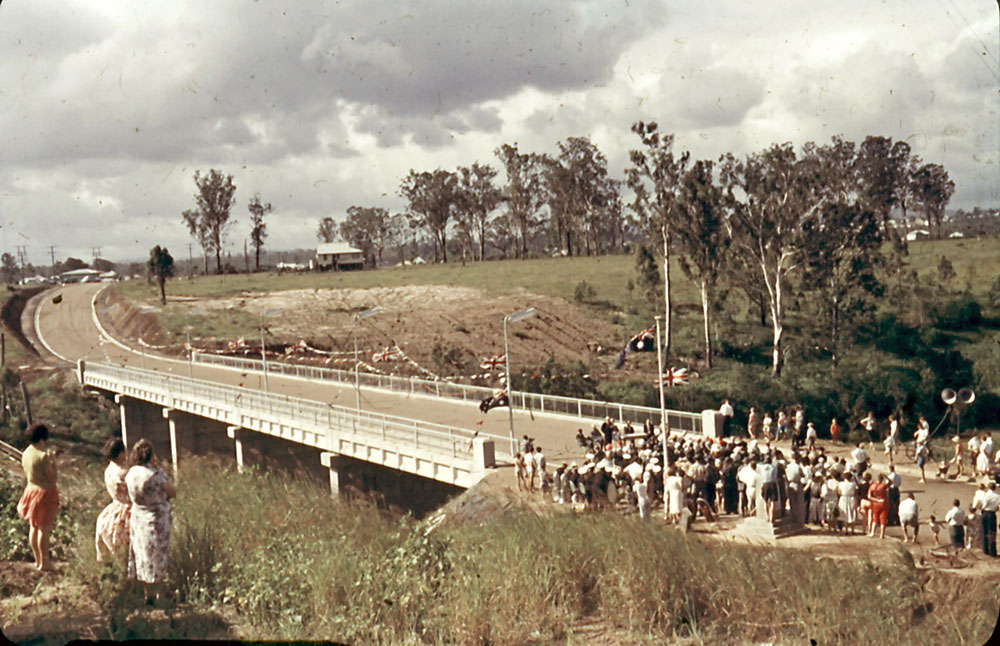The Hancock Bridge, joining Woodend and Brassall, was officially opened 60 years ago on 18 March 1961.
Flags and bunting decorated the bridge as about 100 official guests and spectators watched the ceremony.
The Mayor of the day Alderman Jim Finimore, Ipswich’s longest serving Mayor from 1950 until 1972, unveiled a plaque and cut a blue ribbon with a pair of gold scissors which were then presented to him as a memento of the occasion.
According to an article in the Queensland Times, he said in his speech that ‘”increasing industry caused Ipswich to be a vulnerable place in time of war”.’
“It was essential that new bridges be built capable of carrying heavy traffic.”
Mayor Finimore also remarked that the bridge had become necessary because of developments in the housing industry.
“Over the last 12 years an average of 750,000 pounds a year had been spent on new homes,” he said.
“In the last year this amount had reached 1,266,000 pounds.”
But this bridge was not the beginning of the story.
The Hancock Bridge was built alongside the Harlin Road Bridge which was the first bridge joining the suburbs about 40 years before.
The Harlin Road Bridge was constructed after the residents and Brassall and Woodend rallied together in 1913 to have Ipswich joined with North Ipswich.
Together the community raised the funds to contribute half of the estimated cost, 1,800 pounds.
Tenders were call in late 1915 and the bridge was completed in 1918 at a cost of 5,140 pounds.
The plaque from the old Harlin Road Bridge was remounted on the southern approach to the new Hancock Bridge.
Hancock Bridge facts from 1961
The bridge cost a total of 131,000 pounds. It was made of prestressed concrete 30 foot wide with five 60 foot spans. The highest point was about 40 foot above water level and it was believed it would be free from flooding.
It was believed to be the first bridge in Queensland with a casting as large as its beams.
Ipswich Mayor Teresa Harding said the Hancock Bridge is not only a reminder of the city’s rich heritage structure but remains an essential river crossing for thousands of residents each day.
“River and creek crossings remain an important part of the infrastructure mix to meet the needs of our fast-growing city,” Mayor Harding said.
“The first piece of construction for the planned upgrade and duplication of the Springfield Greenbank Arterial will be a single span bridge crossing Opossum Creek on Springfield Parkway and Springfield Greenbank Arterial.
“Council is also seeking funding support from all levels of government on a second CBD Bremer River crossing, which will ease congestion, revitalise the city centre and stimulate economic growth.”
Hancock Bridge official opening in 1961. Image: Picture Ipswich
The plaque from the old Harlin Road Bridge was remounted on the southern approach to the new Hancock Bridge and can still be seen today
Thomas Hancock (Senior) 1880s. Image: Picture Ipswich
Hancock Brothers Sawmill 1920s. Image: Picture Ipswich
Vivian Edgar Hancock 1910. Image: Picture Ipswich
Why is it called Hancock Bridge? Meet the Hancocks
Thomas Hancock senior came to Australia from Cornwall with his family in 1856 moving to the district in 1864.
He established a sawmill in the Rosewood scrub area in 1867 before moving to Ipswich and setting up a timber yard.
In 1878 they added the North Ipswich timber mill to their business and were able to turn out 50,000 feet of sawn timber per week.
In 1880 Mr Hancock purchased land at Lamington Parade in North Ipswich along the Bremer River and set up a large mill with three storeys which would become their main office; the business now known as Thomas Hancock & Sons.
Thomas senior retired from the business in 1884 and passed away in 1891 leaving his two sons, Thomas junior and Josias to run the business.
The historic home known as “Fairy Knoll” is located on the corner of Whitehill and Robertson Road was built in 1901 for Thomas Hancock Junior and his wife Louisa.
After a fallout between the brothers Thomas Jnr and Josias, Josias moved away from the Hancock Mill leaving Thomas Jnr running the business. In 1898, Josias Hancock along with Joseph Gore established Hancock and Gore.
By 1945 the company became Australia’s largest producer of plywood.
By 1990, the fourth generation of the Hancock family were still running the Hancock mill at North Ipswich and new products such as plywood decking were being made. In 1995 Boral bought the company. In 2011 Boral Hancock Plywood closed its doors.
Viv Hancock (pictured) was in attendance at the opening of the bridge.
To read more about Hancock’s timber mill or the history of Ipswich, visit the Viva Cribb Local History Room located at the Ipswich Central Library or go to the Picture Ipswich database at www.library.ipswich.qld.gov.au
Read also:

